|
THE INVENTION OF THE
PENDULUM CLOCK
PART 2/5
The
workshop of
Salomon Coster

(Type
Ctrl+F
to find any text on this page)
 COSTER'S WORKSHOP
&
COWORKERS COSTER'S WORKSHOP
&
COWORKERS
In the period between mid-1657,
when Coster got the Patent (Privilege) to make pendulum clocks according to
Huygens’ invention, and end-1659, when Coster suddenly died, several clockmakers
worked in Coster’s workshop. His coworkers were Christiaan Reijnaert
(apprenticed from November 1655), John Fromanteel (apprenticed from September
1657 till May 1658), Nicolas Hanet, and Severijn Oosterwijck.
Over the
past decades there has been an on-going and interesting debate about the
involvement of particularly one of these apprentices, John Fromanteel, in the
development and production of the clocks in Coster’s workshop. The paramount
question is: Is it possible to attribute any of the Coster clocks to one
specific clockmaker in his workshop?
On the basis of historical facts and
by comparing technical details of clocks and movements we hope to bring more
clarity in this matter.
The Coster clocks discussed in this article are
limited to Coster clock N1, N2, N4, N5 and N10
(1.
Coster clocks N3 and N8 are being disregarded in this article, for reasons of
uncertain authenticity.
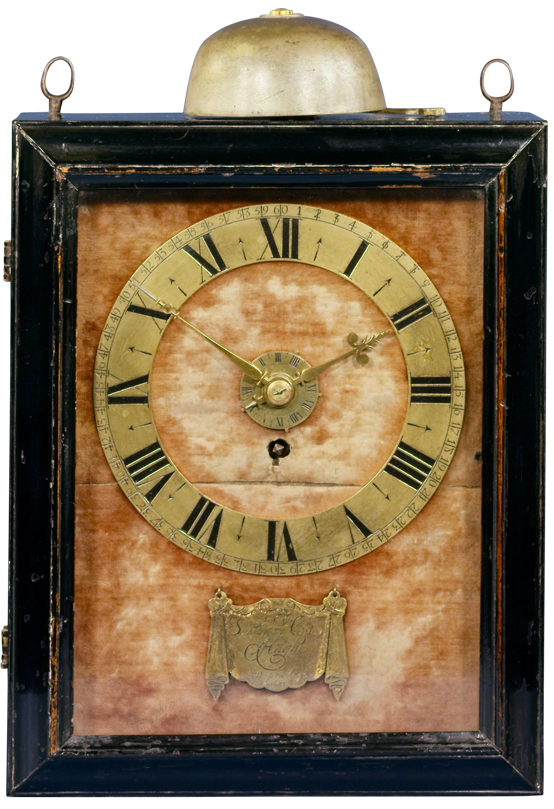
fig. 1

Fig. 2
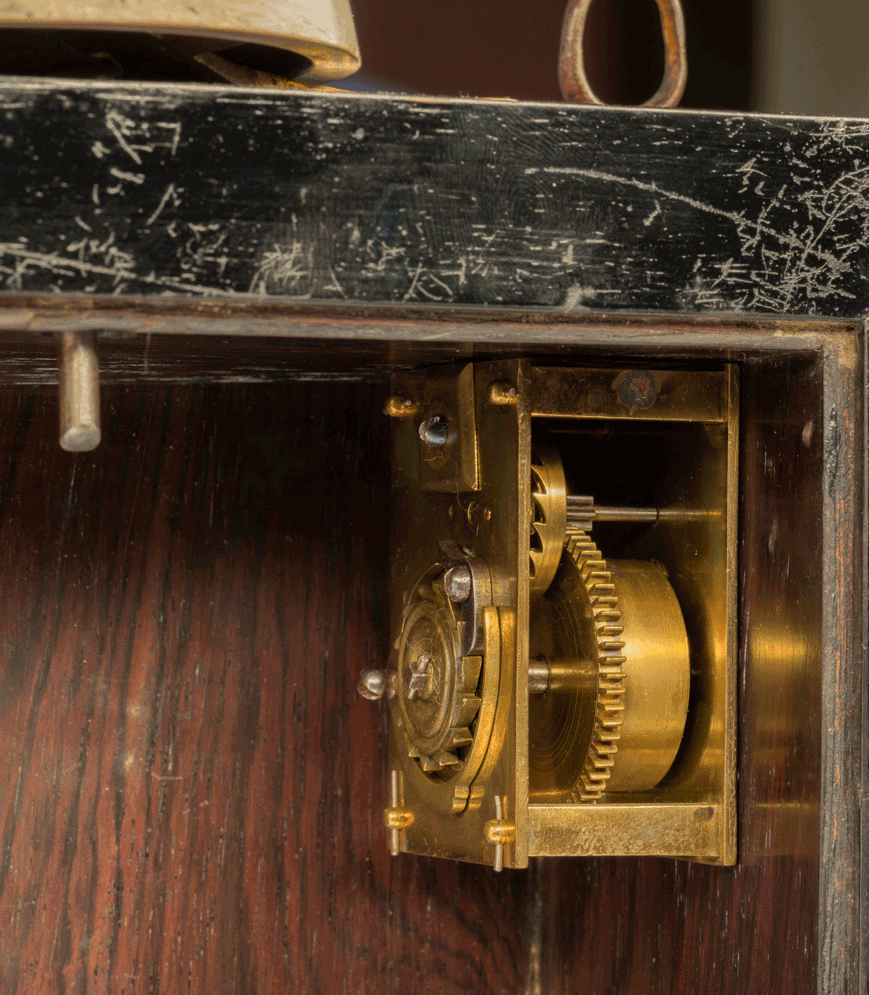
fig. 3
Salomon Coster (N5)
Timepiece with alarm. Duration
30 hours.
The only known Coster clock with alarm work.
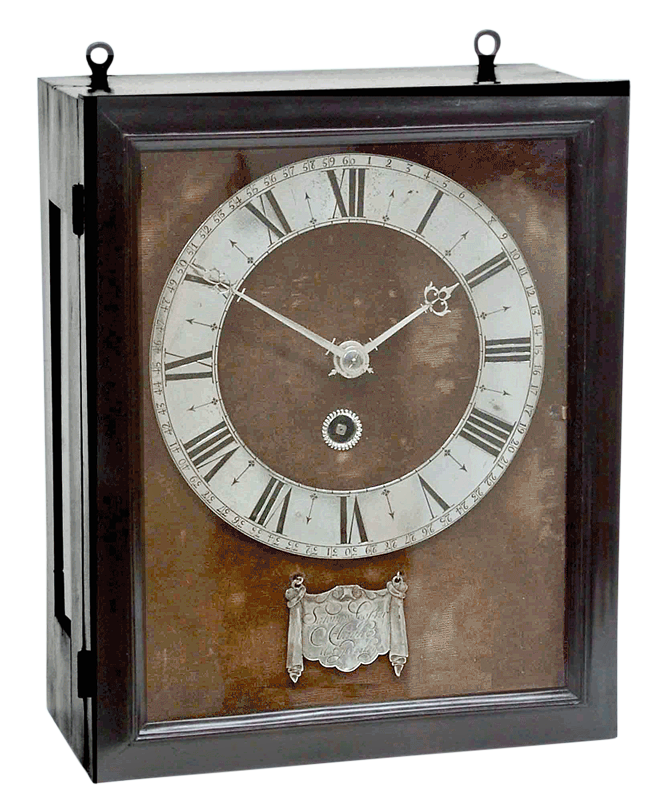
Fig. 4

Fig. 5
Salomon Coster (N10)
Going and striking on one barrel.
Duration 30 hours.
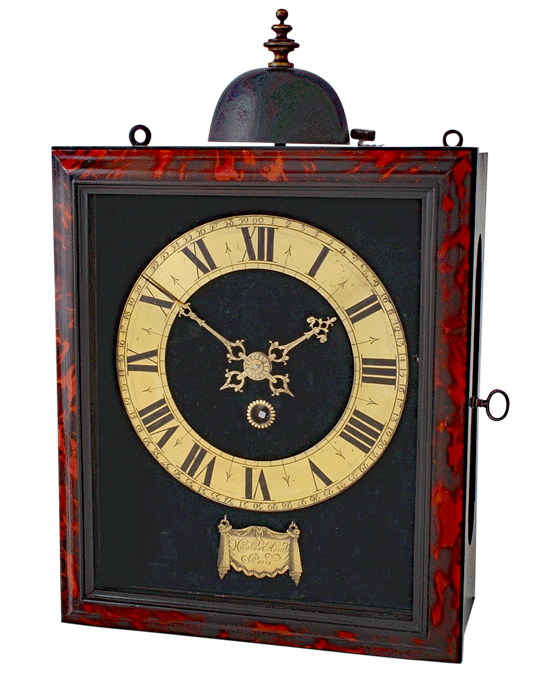
fig. 6
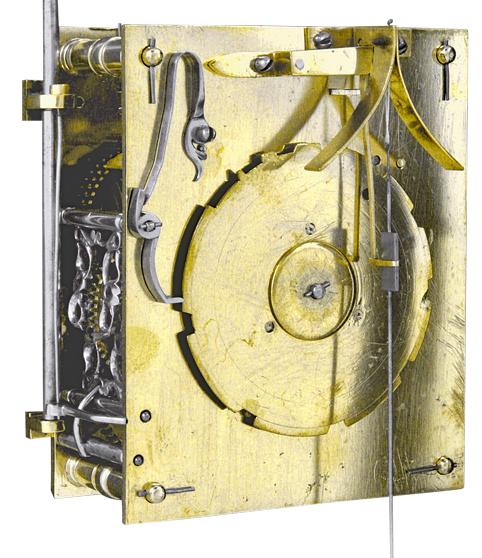
fig. 7
Nicolas Hanet going and striking on one barrel.
Duration
2 days.

fig. 8
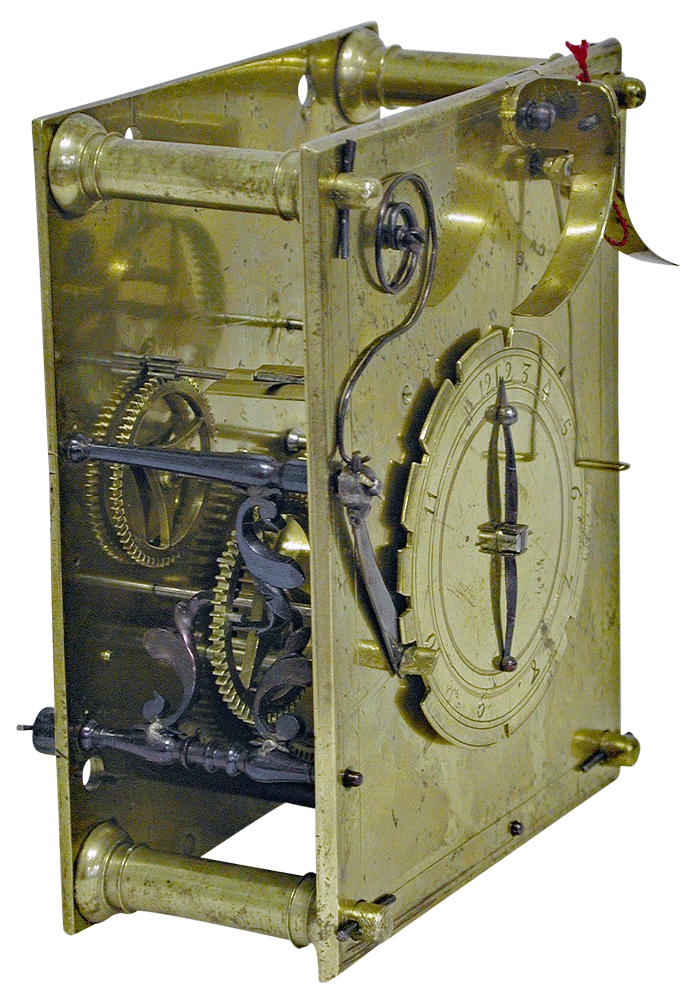
fig. 9
Severijn Oosterwijck N9
Going and striking trains on
one barrel.
Duration 30 hours.
 FROMANTEEL OR COSTER
FROMANTEEL OR COSTER
John Fromanteel (2,
born in 1638, was apprenticed to his father Ahasuerus Fromanteel, on the 5th of
April 1652, for a period of seven years. During his apprenticeship he served,
according to the rules of the Clockmakers’ Company, under master clockmaker
Salomon Coster for a period of eight months starting in September 1657 and
ending in May 1658. In the period after his departure in 1658 until the death of
Coster in December 1659 no reference to John Fromanteel is found In the
Oeuvres Complètes (3
nor in the public archives in the Netherlands.
We may therefore assume, that John Fromanteel was not involved in the further
development of the pendulum clock in Holland.
There are three early
clocks known by Fromanteel, which show features resembling Coster clocks: the
so-called 1658 Lyme Park Movement, the 1658/1659 Bass Fromanteel and the
1658/1659 Taylor Fromanteel.
 LYME PARK MOVEMENT LYME PARK MOVEMENT
The oldest known movement,
the Lyme Park Movement (National Trust)
(4, was
discovered in about 1940, in a very bad condition. The case was lost,
the movement had been converted to anchor and only a small section of
the original dial remained with its original hands.
-kopie.png)
fig. 10
1658, A. Fromanteel London Fecit 1658
“Lyme Park Fromanteel”
Collection The National Trust
-kopie.png)
fig 11.
A. Fromanteel London Fecit 1658
“Lyme Park Fromanteel”
Collection The National Trust
The movement was restored and reconstructed by Mr Charles Hobson (5. All parts
above the contrate pinion were replaced in the style of Dutch work with
a new horizontal crown wheel and verge. A silk suspended pendulum and
cycloid cheeks were added. According to Mr. Ronald A. Lee, during the
restoration Hobson had to drill and tap extra holes to mount cheeks in
the style of Dutch work that had not been there originally (6. Mr. J.W.
Parkes made a new dial similar to the original. The chapter ring was
copied from an authentic Dutch ring, but unfortunately wrong engraved
with the figures 0-60 twice. The new case was constructed in the
Architectural style in the tradition of the 1660’s. The movement is
signed A Fromanteel London fecit 1658. The date is not placed centrally
giving the impression, that it was an afterthought.
 BASS
FROMANTEEL BASS
FROMANTEEL
The verge is pivoted on the front plate and back cock: the latter
being original but modified to accept a silk suspended pendulum with the
original bob(7.
The minute hand is a replacement copied from the Taylor Fromanteel.
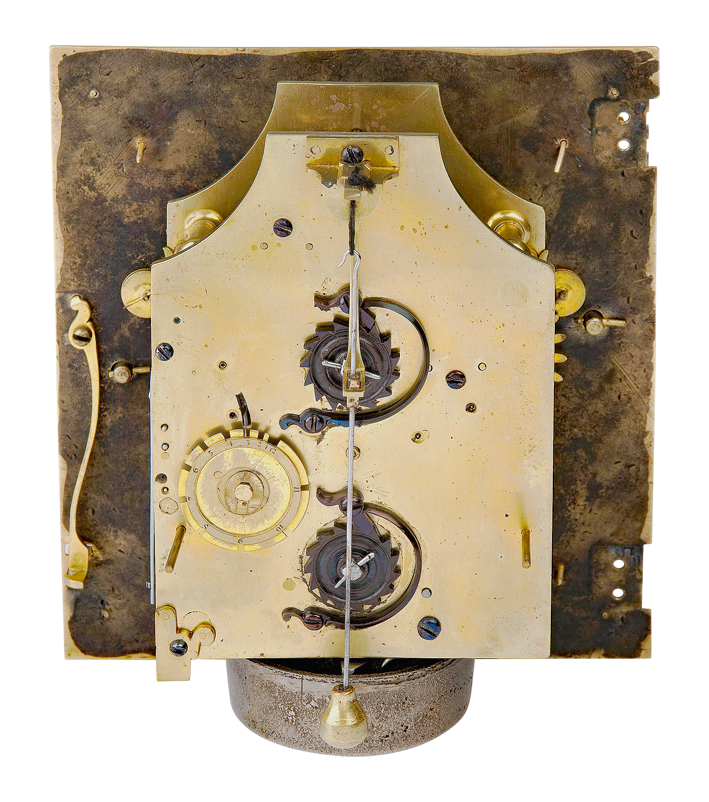 
Fig. 12
1659. A Fromanteel Londini
“Bass Fromanteel” Private collection
%20kopie.png)
Fig. 13
1659. A Fromanteel Londini
“Bass Fromanteel” Private collection
endsection
%20kopie.png)
Fig. 14
1659. A Fromanteel Londini
“Bass Fromanteel” Private collection
End
of this section, click
here to continue.


|
 TAYLOR FROMANTEEL
TAYLOR FROMANTEEL
The Taylor Fromanteel
(8
is the most authentic of the three clocks. The pallet
arbor is a replacement
(9
and there is an unidentified hole in the top of the back cock. The
engraved cartouche above the chapter ring with initials 16 E+W 87 is a
later addition.
%20kopie.png)
fig. 15
1659. A Fromanteel Londini
“Taylor Fromanteel” Private collection
%20(1)%20kopie.png)
Fig. 16
1659. A Fromanteel Londini
“Taylor Fromanteel” Private collection
%20kopie.png)
Fig. 17
1659. A Fromanteel Londini
“Taylor Fromanteel” Private collection
 COMPARISSONS
COMPARISSONS
Comparisson Coster N1, N2, N4, N5, N10
Fromanteel Lyme Park, Bass, Taylor.
● The
Similarities
|
|
|
COSTER |
FROMANTEEL |
|
|
1. |
pillars square (except N10).
|
pillars square Lyme Park. |
|
|
2. |
barrel(s) without fusee. |
barrel(s) without fusee. |
|
|
3. |
case in the shape of a simple box. |
case in the shape of a simple box (except Lyme Park). |
|
|
4. |
movement attached to the dial plate and turning on hinges at
the left hand side (except N5 which turns on pins). |
movement attached to the dial plate and turning on hinges at
the left hand side (except Lyme Park).
|
●
The Differences
Case
|
|
|
COSTER |
FROMANTEEL |
|
|
1. |
rectangular. |
square
(except Lyme Park) |
|
|
2. |
side
panels closed (except N10). |
side panels glazed, the right sight
panel slides up (except Lyme Park). |
|
|
3. |
wall clocks. |
table
clocks. |
|
|
|
|
|
|
|
4. |
Case dimensions |
Height cm. |
|
|
|
|
|
|
|
|
Coster N1 |
27,2 |
|
|
|
Coster N2 |
26,4 |
|
|
|
Coster N4 |
23,4 |
|
|
|
Coster N5 |
27,5
(32,5 bell included) |
|
|
|
Coster N10 |
26,1 |
|
|
|
Fromanteel Lyme Park |
40,7 |
|
|
|
Fromanteel Bass |
19,7 |
|
|
|
Fromanteel Taylor |
20,7 |
●
The Differences
Dial
|
|
|
COSTER |
FROMANTEEL |
|
|
1. |
dial plate rectangular. |
Fromanteel: dial
plate square (except Lyme Park). |
|
|
2. |
dial plate covered with dark
velvet. |
dial
plate not covered with velvet, but instead a matted centre
and corner spandrels (except Lyme Park). |
|
|
3. |
chapter ring gilt brass or
solid silver. |
chapter
ring silver face soldered to a brass under-ring with
12 solder holes in the brass ring(10. |
|
|
4. |
hands silver or gilt.
|
hands
iron. |
|
|
5. |
signature
on a signature shield in the form of a lambrequin. |
signature engraved on the dial
plate (except Lyme Park). |
|
|
6. |
a hole in the dial plate behind
the signature shield directly in
front
of the pendulum. |
no hole. |
●
The Differences
Movements
|
|
|
COSTER |
FROMANTEEL |
|
|
1. |
pillars square (except N10) |
pillars
ringed round instead of square (except Lyme Park). |
|
|
2. |
pillars pinned on the back
plate. |
pillars latched to the front plate. |
|
|
3. |
verge with a silk suspended
pendulum with cycloid cheeks. |
verge pivot directly connected to the
pendulum (except Lyme Park).
The bridge of the Bass Fromanteel is adapted and now has a silk suspended pendulum. |
|
|
4. |
crown wheel set in a
horizontal position of 90 degrees. |
crown wheel
set in an angle of 70 degrees (except Lyme Park). |
|
|
5. |
a
hole in the back plate to facilitate the escapement wheel. |
no hole. |
|
|
6. |
ratchet N1, N2, N4 on the front
plate. N5: ratchet visible at the back plate. N10:
ratchet hidden behind the back plate on the barrel. |
ratchets visible on the back plate |
|
|
7. |
timepieces with one barrel
(except N10). |
two vertically positioned barrels, one for going and one
for striking
(except Lyme Park). |
|
|
8. |
30 hour’s duration.
|
Bass and Taylor:
3 days duration. Lyme Park: 8 day’s duration. |
|
|
9. |
movement elongated rectangular
shape (except N10). |
movement rectangular with curved
shoulders (except Lyme Park) and of a heavier, larger and sturdy construction. |
|
|
10. |
movement not signed. |
movement Lyme
Park signed. |
|
|
|
|
|
|
|
11. |
Movement dimensions |
Height - Width mm. |
|
|
|
|
|
|
|
|
Coster N1 |
110
- 59 |
|
|
|
Coster N2 |
109
-
58 |
|
|
|
Coster N4 |
109
-
59 |
|
|
|
Coster N5 |
110
-
59 |
|
|
|
Coster N10 |
109
-
84 |
|
|
|
Fromanteel Lyme Park |
220
-
110 |
|
|
|
Fromanteel Taylor |
139
-
107 |
|
|
|
|
|
 SPECIAL CHARACTERISTICS SPECIAL CHARACTERISTICS
● There are two movements with special
characteristics, different from all other Coster movements.
1. The Lyme
Park movement is considered to be the earliest movement made by Fromanteel and
most similar to Coster’s. The Lyme Park movement has square pillars like the
Coster movements, which are latched to the front plate instead of pinned on the
back plate(11.
The ratchet is visible on the back plate. The movement is not attached to the
hinged dial plate and is much larger than the Coster movements and very sturdy (12.
The dimensions of the Lyme Park movement are 220 mm height and 110 mm width(13;
the dimensions of the early Coster movements are 109/110 mm height and 59/58 mm
width.
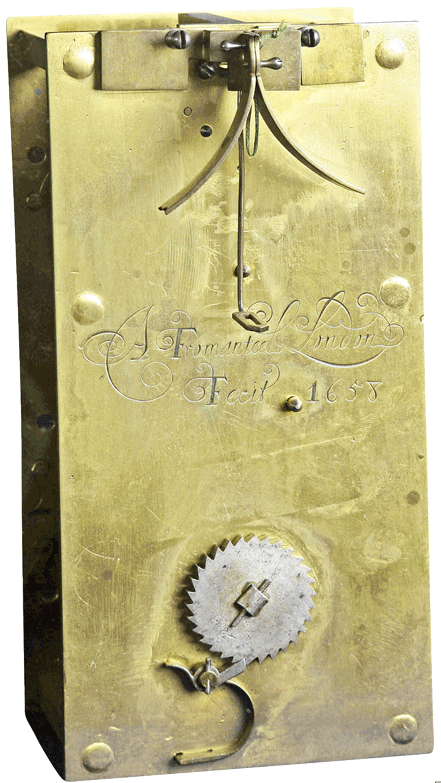 |
 |
Lyme Park
H. 220 mm. |
Coster
H. 110 mm. |
2. The Taylor Coster clock N5 movement has
square pillars pinned on the back plate like all other Coster movements.
However, the dial plate is turning on pins instead of hinges and the
ratchet is visible on the back plate in the Fromanteel manner in
contrast to all other Coster movements. This is the only Coster clock
with an alarm and bell on top of the case. The alarm is presumably a
slightly later addition.
●
Pillars
R.D. Dobson(14
states that the square pillars of the movements from the Coster workshop were
produced under the influence of John Fromanteel. After John’s departure in May
1658 not Coster, but the Fromanteels exclusively used square pillars. However,
the way the pillars are attached to the movements is different, all Coster
movements having the pillars pinned on the back plate, while the pillars in the
Fromanteel movements are latched to the front plate.
Moreover, in the
late 16th century/early 17th century, square pillars were already used
extensively in Germany by master clockmakers in the well-known renaissance table
clocks
(15.
For instance, master clockmaker Johann Sayller used square pillars in several of
his clocks.
In the catalogue Innovation & Collaboration(16 ,
page 56, the pillar depicted in fig. 3.3 is designated as ‘Ahasuerus Fromanteel
square pillar’. This type of pillar is commonly known and designated as an
‘Egyptian pillar’; it was widely used in watches of that period.

Fig. 18
Renaissance clocks and movements
with ‘square pillars’
 CONCLUSION
CONCLUSION
The only true resemblances between the Coster and Fromanteel
clocks are:
●
The shape of the simple box type case (except the Lyme Park movement).
●
The dial hinged, turning on the left hand side (except the Lyme Park movement).
●
No fusee in the movements.
According to the rules of the Clockmakers’ Company, in the apprenticeship
and journeyman period the clock had to be signed by the serving master, not
by the apprentice. So the Taylor clock (N5), although signed by Coster, may
well have been made by John Fromanteel. However, because of the lack of
historical evidence, and in view of the aforementioned technical differences
in movements and cases, it is not justified to attribute Coster clocks N1,
N2, N4, N10 and N5 with certainty to any of the clockmakers in Coster’s
workshop (Coster, Fromanteel, Hanet, Reijnaert or Oosterwijck).
 ACKNOWLEDGEMENTS
ACKNOWLEDGEMENTS
Photo 1,2,3 : Courtesy of Dr. John C. Taylor, Isle of Man
Photo 4,5 :
Courtesy Mario Crijns, Breda
Photo 6,7 : Courtesy Mentink & Roest,
Ingen
Photo 8,9 : Courtesy Stichting Boom-Time
Photo 10,11 :
Courtesy of The National Trust Images, Swindon
Photo 12,13,14 :
Courtesy of Ben Wright, Tetbury
Photo 15,16,17 : Courtesy of Dr. John
C. Taylor, Isle of Man
March
2019, Copyright:
(This article is subject to ongoing
revisions.)
 LINKS LINKS
Chr.
Huygens' Œuvres Complètes.
(pdf)
Chr.
Huygens Horologium 1658.
(pdf)
 NOTES NOTES
|
|
|
|
1 |
N1 1657 - Rijksmuseum Boerhaave
Leiden
N2 1657 - Collection Zuylenburg/Bert Degenaar
former Vehmeyer Collection
N4 1658 - Science Museum former Dr. R. Plomp
N5 1658 - Dr. John C. Taylor
former P.C. Spaans Collection
N10 1659/1660, - Private
Collection former Mario Crijns
|
|
2 |
The Worshipfull Company of Clockmakers, Minutes of 1652, James Nye Chairman
A.H.S.
|
|
3 |
Oeuvres Complètes de Christiaan Huygens, Tome
II, correspondance 1657-1659,
Martinus Nijhoff 1889 – Tome
XVII, l’horloge à pendule 1656-1666, Martinus Nijhoff 1932
|
|
4 |
Ronald A. Lee, The first twelve years of the English Pendulum Clock, London 1969
|
|
5 |
Percy G. Dawson, C.B. Drover & D.W. Parkes,
Early English clocks, Aberdeen 1982,
page 75
|
|
6 |
Dr.John C. Taylor,
The Coster Fromanteel contract 3rd September 1657 Changes
made during
drafting, Isle of Man 2018,
page 1 footnote
|
|
7 |
Ben Wright, Exceptional
Clocks, Tetbury 2018
|
|
8 |
Ronald A. Lee, The first twelve years of the English Pendulum Clock, London 1969
|
|
9 |
Percy G. Dawson, C.B. Drover & D.W. Parkes,
Early English Clocks, Aberdeen 1982,
page 84
|
|
10 |
Ben Wright, Exceptional
Clocks, Tetbury 2018
|
|
11 |
Dr. R. Plomp, Spring-driven Dutch pendulum clocks 1657-1710, Schiedam 1979, page
24
|
|
12 |
Percy G. Dawson, C.B. Drover & D.W. Parkes,
Early English Clocks, Aberdeen 1982,
page 75
|
|
13 |
Amey
Carney, House and Collections Manager |
|
14 |
R.D. Dobson, De slinger als tijdmeter, Bocholt 1999,
page 43A |
|
15 |
Klaus Maurice, Die deutsche Räderuhr, Munich 1976, page 600 |
|
16 |
Richard Garnier & Leo Hollis, Innovation & Collaboration, Isle of
Man 2018, page 56 |
|
|
|

|










-kopie.png)
-kopie.png)


%20kopie.png)
%20kopie.png)
%20kopie.png)
%20(1)%20kopie.png)
%20kopie.png)

